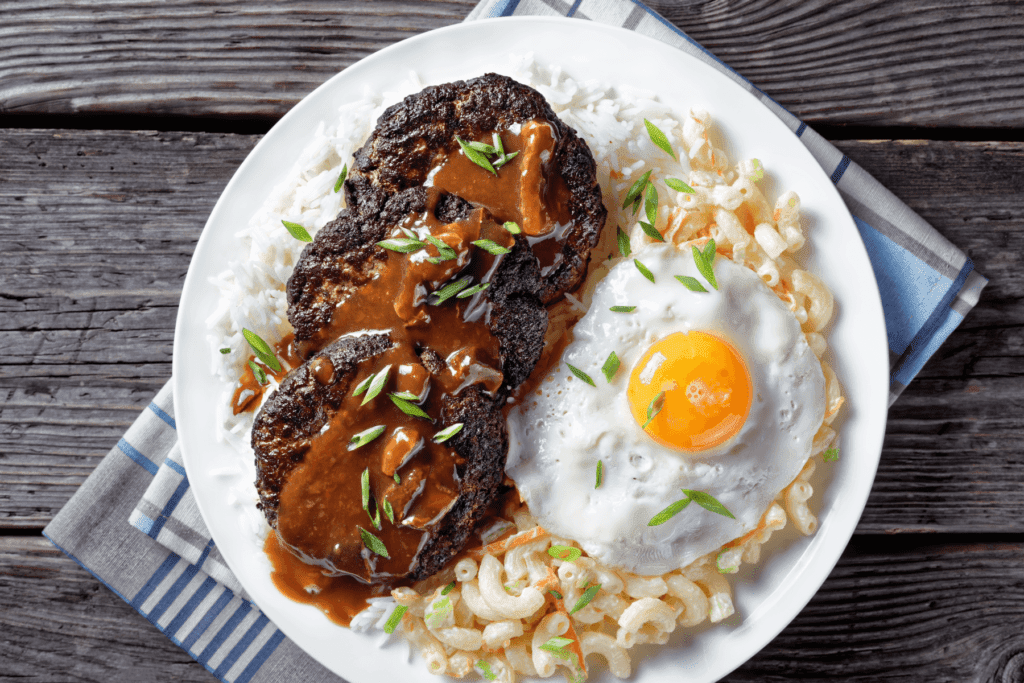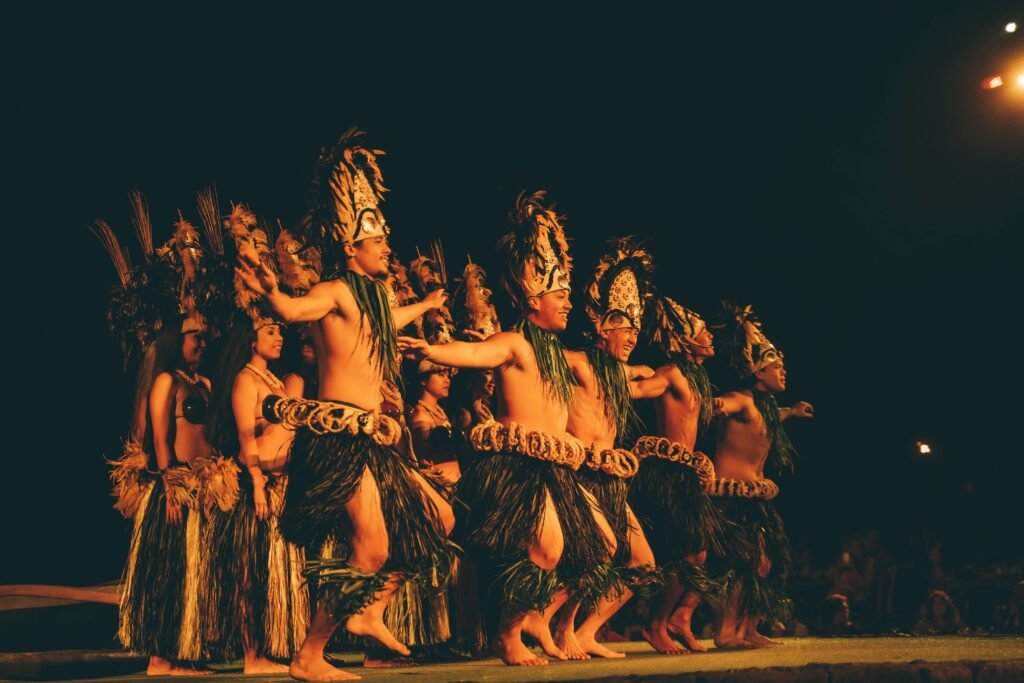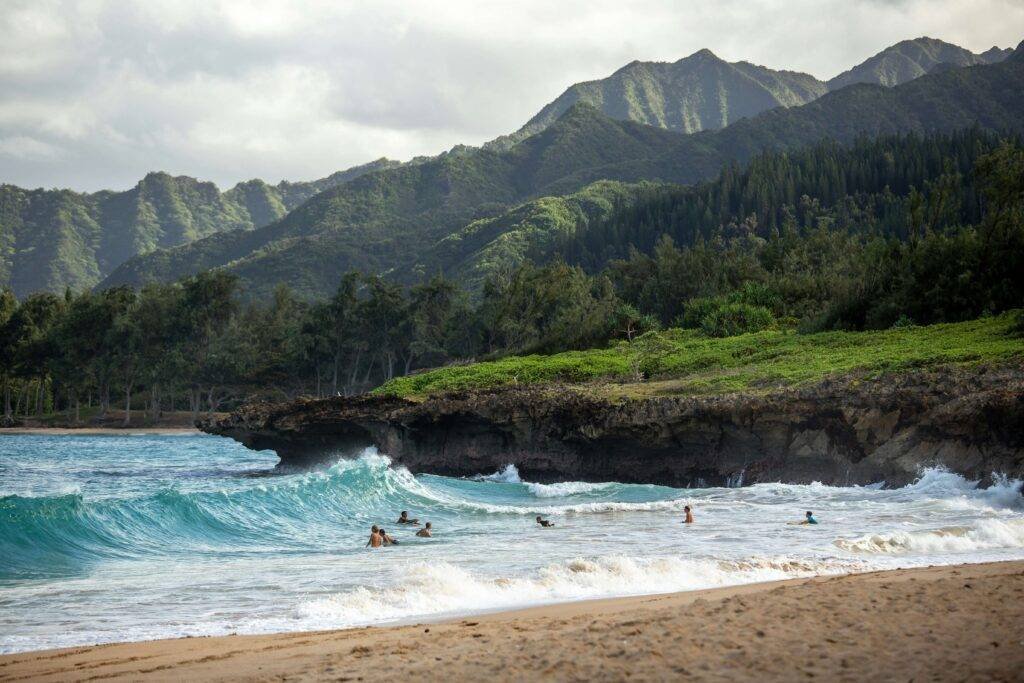Planning your first trip to Hawaii can feel overwhelming, but it’s worth every moment. We were lucky enough to have our dear friends, who visit the islands annually, and plan our Waikiki adventure for us. This meant we could simply relax and enjoy the stunning beaches, vibrant culture, and delicious food without the stress of planning. Our trip was so incredible that we’re already planning to return. Whether you’re flying solo or traveling with friends, this guide will help you plan the perfect first trip to Hawaii, ensuring you make the most of your tropical getaway. Let’s dive into the essentials and insider tips to make your Hawaiian dream vacation a reality!
Table of Contents
Introduction
Known as the “Aloha State,” Hawaii is one of the most beloved vacation destinations in the world. Comprised of six major inhabited islands – Oahu, Maui, Kauai, Molokai, Lanai, and the Island of Hawaii – Hawaii boasts stunning beaches, lush rainforests, cascading waterfalls, and live volcanoes. It’s also famous for its unique Polynesian culture and the spirit of “aloha,” which emphasizes love, compassion, and harmony.
For a first time visitor, we’ll focus on the three most popular islands:
- Oahu – Home to the capital Honolulu and famous Waikiki Beach. Great for nightlife, shopping, and surfing.
- Maui – Known for its resorts, whale watching, and the Road to Hana scenic drive. More laidback vibe.
- Island of Hawaii – Largest island with active volcanoes, black sand beaches, and historic Kona district. Offers a variety of experiences.
With its postcard-worthy landscapes, warm tropical climate, and friendly locals, Hawaii offers an unforgettable vacation for all interests and budgets. It’s no wonder why Hawaii remains a top bucket-list destination for travelers around the world.
Getting There
The vast majority of travelers visiting Hawaii for the first time will arrive by plane into Honolulu International Airport (HNL) on the island of Oahu. This is Hawaii’s largest and busiest airport, making it the gateway for most first-timers.
Direct flights are available to Honolulu from several major US cities, including Los Angeles, San Francisco, Seattle, Denver, Dallas, Chicago, Atlanta, and New York. If you’re coming from another part of the US, you’ll likely need to connect through one of these hub cities.
The flight time from the West Coast is about 5-6 hours, while flights from the East Coast can take 10 hours or more. If you’re coming from Asia or Oceania, Honolulu is a major transit hub with many non-stop connections available.
Other main airports in Hawaii include Kona International Airport (KOA) and Hilo International Airport (ITO) on the Big Island, Kahului Airport (OGG) on Maui, and Lihue Airport (LIH) on Kauai. These receive far fewer direct long-haul flights but are accessible via connections through Honolulu.
While flying into Honolulu is the easiest for first-timers, you may want to consider flying directly to the island you plan to focus on if you don’t intend to spend much time on Oahu. This can save you time and the hassle of an inter-island flight.
Accommodations
Hawaii offers a wide variety of accommodation options to suit different budgets and preferences. Here are some of the main types to consider:
Resorts
Resorts are a popular option, especially for those who want a relaxing, pampered vacation. They offer amenities like multiple pools, restaurants, spas, golf courses, kids clubs, and oceanfront views. Some well-known resort brands in Hawaii include Marriott, Hilton, Hyatt, Four Seasons, and Aulani (Disney).
Pros: All-inclusive amenities, don’t have to leave the property, kid-friendly options
Cons: Can be expensive, less authentic than other lodging options, resort fees
Hotels
Hotels range from affordable chains like Best Western to luxury 5-star properties. They offer easy accommodation without all the resort frills. You’ll get a comfortable room and most likely a pool and restaurant or two. Some are located right on the beach.
Pros: More affordable, flexible location options, basic amenities
Cons: Fewer amenities than resorts, less room space than vacation rentals
Condos/Vacation Rentals
Condos and vacation rentals give you more space and often access to a kitchen. Many are beachfront and offer resort-like amenities at a fraction of the price. Great for families or longer stays. Use sites like Airbnb, Vrbo and Vacasa.
Pros: More space, household amenities, beachfront options, lower cost
Cons: No daily housekeeping, less service, need a rental car
Hostels and B&Bs
For budget travelers hostels and bed & breakfast inns offer low rates starting around $25/night. You’ll get a bed, shared bathrooms, and some communal facilities. Hawaii has some unique hostel options too like yurts and treehouses!
Pros: Very affordable, meet fellow travelers
Cons: Less amenities and service, shared bathrooms, smaller rooms
When choosing accommodations, consider your budget, desired amenities, purpose of trip, length of stay and location preferences to find the best option. There are great lodging choices across the islands for all travelers.
Top Activities
Hawaii offers an abundance of things to see and do on each of its major islands. Here are some of the top activities and attractions to consider:
Oahu
- Waikiki Beach – Famous stretch of sand with hotels, restaurants, and lots of people watching. Excellent for swimming, sunbathing, surf lessons.
- Diamond Head State Monument – Iconic volcanic crater offering sweeping views from a 0.8 mile hike.
- Pearl Harbor and USS Arizona Memorial – Historical site and museum chronicling the Pearl Harbor attacks.
- Hanauma Bay – Curved white sand beach ideal for snorkeling with colorful fish.
- Kualoa Ranch – Lush valley offering ATV tours, ziplining, horseback riding and more.
- North Shore Beaches – Legendary surfing spots like Pipeline, Waimea Bay and Sunset Beach.
Maui
- Road to Hana – Curvy scenic drive with lush rainforests, waterfalls and black sand beaches.
- Haleakala Crater – Drive or hike into the lunar-like volcanic crater at sunrise or sunset.
- Snorkeling at Molokini – Snorkel tour to crescent-shaped crater teeming with tropical fish.
- Makena Beach – “Big Beach” famous for golden sand and tranquil waters.
- Ho’okipa Beach – Premier windsurfing and surfing beach on the north shore.
Kauai
- Na Pali Coast – Breathtaking cliffs, secluded beaches and waterfalls, seen by hiking, boating or air tours.
- Waimea Canyon – Dubbed the “Grand Canyon of the Pacific” with gorgeous overlooks.
- Poipu Beach – Swimmable protected bay perfect for families and snorkeling.
- Wailua Falls – Jaw-dropping double falls accessible by short walk.
- Fern Grotto – Boat cruise takes you into an ancient lava rock cave full of tropical ferns.
Big Island
- Hawai’i Volcanoes National Park – Explore volcanic craters, lava fields and steam vents.
- Mauna Kea Summit – Drive or take a tour to the 13,000+ foot summit for stargazing.
- Akaka Falls – See the spectacular 442-foot falls on the lush Hamakua Coast.
- Kona Coffee Farms – Take a tour and tasting at coffee plantations like Greenwell Farms.
- Kealakekua Bay – This marine preserve offers some of the islands best snorkeling.
With so many incredible sights and activities, you really can’t go wrong visiting any of the main Hawaiian islands. Just be sure to leave plenty of time to relax on the beach!
Food and Dining
One of the best parts about visiting Hawaii is experiencing the incredible local cuisine. Hawaiian food is a unique fusion of Polynesian, Japanese, Chinese and American flavors. Popular dishes include poi, poke, kalua pork, loco moco, lau lau and haupia for dessert. While traditional Hawaiian delicacies emphasize simplicity, local chefs have also pioneered the island’s own distinctive brand of Pan-Pacific fusion cuisine, blending classic dishes with global ingredients and techniques.
Some must-try staples in Hawaiian cuisine include:
- Poi – A staple food made from mashed taro root. It has a unique purple color and sweet, nutty taste.
- Poke – Cubed, raw, marinated tuna or other types of fish. It’s often mixed with soy sauce, sesame oil, seaweed and spices to create a refreshing appetizer or snack.
- Kalua Pork – Pork shoulder roasted traditionally in an underground oven called an imu. It’s incredibly tender and flavorful.
- Loco Moco – A classic local comfort food of hamburger patties and rice topped with fried egg and brown gravy.
- Lau Lau – Pork or fish wrapped and steamed in ti leaves, imparting herbal flavor.
- Haupia – A creamy coconut milk-based dessert often served as a topping on cake.
On Oahu, top restaurants for experiencing Hawaiian cuisine include:

- Helena’s Hawaiian Food – A casual, family-run restaurant serving traditional local dishes. Try the combination plate to sample different items.
- Ono Seafood – Specializing in the freshest poke bowls, seafood plates and more. A great lunch option with locations throughout Honolulu.
- Haleiwa Joe’s – Famous for Hawaiian fusion dishes with a focus on fresh seafood. Watch the surfers and sunset on the outdoor deck.
- Alan Wong’s – Upscale establishment pioneering Hawaii Regional Cuisine with locally-sourced ingredients prepared in creative ways.
On Maui, check out Star Noodle and Mama’s Fish House for innovative takes on local flavors. On Kauai, try Pono Market and Koloa Fish Market for grab-and-go Hawaiian specialties. And on the Big Island, sample Olu Cafe and Suisan Fish Market. With fresh seafood, tropical fruits and vegetables, Hawaii offers a truly unforgettable foodie experience.
Weather and When to Visit
Hawaii is known for its consistently warm tropical climate year-round. However, there are subtle differences in weather on each island that are good to know when planning your ideal time to visit.
On Oahu, the weather stays relatively constant throughout the year, with average daily highs of 80-90°F and lows of 65-75°F. Winter months (November-March) tend to be a few degrees cooler with more rain. Summer is slightly hotter and drier. Overall, any time of year is ideal for enjoying Oahu’s beaches.
The Big Island has more variation in climate due to its size. The Kona side has abundant sun with very little rain. The Hilo side gets more overcast skies and frequent rain showers. For the best combination of sun and comfortable temps, visit the Big Island between April and June or September to November.
Maui has a microclimate that gives it a gentle warmth year-round. Like Oahu, Maui maintains average high temperatures in the 80s with cooler nights dipping into the 60s and low 70s. The winter months tend to be rainier, while summer is hotter and drier. The best time to visit Maui is from late spring through early fall.
Kauai sees more rain compared to the other islands, especially on the North Shore. But it remains warm throughout the year with average highs in the 80s. Avoid the wettest months from November to March, and aim for the sunnier days from May to September.
No matter when you decide to visit, you can count on Hawaii delivering beautiful beaches, stunning landscapes, and endless aloha spirit all year long. The key is choosing the island and time of year that fits your ideal weather preferences.
Getting Around
When visiting Hawaii for the first time, you’ll need to decide the best method of transportation depending on which island you are visiting. Here are some tips:
Oahu
- Rental car – Having your own car is highly recommended for flexibility in seeing all of Oahu. Be aware that traffic can get bad during rush hours around Honolulu. Parking is also challenging in places like Waikiki.
- TheBus – Public buses serve all parts of Oahu. TheBus is an affordable way to get around if you don’t plan to explore outside the main areas. Bring exact change to pay the fare. Buses run less frequently on weekends and holidays.
- Taxis – More expensive than buses but can be convenient for shorter trips where TheBus doesn’t run or if you have luggage.
Maui
- Rental car – A must for exploring Maui beyond the main beach resorts. Be ready to drive the famous Road to Hana and up to Haleakala volcano.
- Public transportation – Buses are limited on Maui. Consider the Maui Bus which serves some popular spots like Lahaina, Kihei, the airport and Whale Center.
- Taxis or Uber – Useful for airport transfers or evenings out if you don’t want to drive.
Kauai
- Rental car – The best way to experience Kauai’s incredible scenery like Waimea Canyon, Na Pali Coast trails, etc. Consider a 4×4 for accessing more rugged areas.
- Public transportation – Kauai Bus is limited to the main towns of Lihue and Hanalei. Taxis or Uber can fill in gaps.
Big Island
- Rental car – Absolutely vital for visiting the Big Island’s diverse locations like Volcanoes National Park, Kona beaches, Waipio Valley, etc.
- Public transportation – Hele-On Bus serves Hilo, Kailua-Kona and some other areas but is very limited.
- Taxis, shuttle services – May work for some visitors sticking to one town or resort area.
Packing Tips
Suggesting what to pack and not to pack for a Hawaii vacation can help ensure you have everything you need for a smooth trip. Here are some tips:
- Bring lightweight, breathable clothing. The weather is warm and humid year-round in Hawaii, so you’ll want shorts, t-shirts, sundresses, and sandals. Cotton and linen fabrics work best.
- Pack a hat, sunglasses, and sunscreen. The Hawaiian sun is strong, so protecting your skin is essential. Reef-safe sunscreen helps protect marine life.
- Bring a swimsuit and coverup. With so many amazing beaches, you’ll want your swimwear. A sarong or light coverup is useful for walking around and for protection from the sun.
- Pack bug spray. Mosquitos can be bothersome, especially at dusk. An insect repellent with DEET offers the best protection.
- Bring an umbrella or light rainjacket. Brief passing showers are common in Hawaii, so being prepared can keep you comfortable.
- Don’t forget your camera/phone. The incredible island scenery will provide endless photo opportunities. Underwater disposable cameras can even work for snorkeling.
- Leave your jewelry at home. Fancy jewelry is risky to lose and out of place in casual Hawaii. Simple, beach-friendly accessories work best.
- Don’t overpack shoes. With so much time spent in sandals or barefoot, you likely only need one closed-toe shoe option for hiking or nights out.
- Don’t bring too many gadgets. Unplug and enjoy the island lifestyle. Phones, cameras, and other essential tech is plenty.
Hawaiian Culture

The Hawaiian culture is rooted in the traditions and beliefs of its indigenous Polynesian people. For centuries, native Hawaiians lived in harmony with the land and sea. Their culture was heavily influenced by their natural environment.
The earliest settlers to the Hawaiian Islands brought their customs and traditions with them when they voyaged across the vast Pacific Ocean. One of the most well-known traditions is the hula dance. Ancient Hawaiians danced hula to honor their gods and chiefs as well as to record their proud history through chants and songs.
The Hawaiian language is another important element of the culture. It continues to be spoken today thanks to determined efforts to revive the language. Key aspects of the language include its repetitive vowels, fluid word order, and use of idioms relying on nature. For instance, kai (ocean) is used in phrases meaning vast, wide, or all encompassing.
The concept of ohana, extended family, lies at the heart of Hawaiian culture. Families care for one another, work together, and celebrate major life events as a bonded group. Elders are deeply respected for their wisdom and experience.
Many Hawaiians also continue cultural traditions like making leis (floral garlands), carving, tapa cloth painting, and canoe building. Passing down these skills to younger generations helps ensure old Hawaiian ways endure. The aloha spirit of warmth, joy, and unity permeates daily life.
Final Tips
- When visiting Hawaii, remember to be respectful of the local culture and natural environment. Avoid overly crowded beaches and trails to limit your impact.
- Use reef-safe sunscreen that doesn’t contain chemicals like oxybenzone or octinoxate, which can harm fragile coral reefs. Look for mineral-based or zinc oxide formulas.
- Don’t take any natural artifacts like coral, shells, rocks or sand home with you. Let Hawaii remain undisturbed.
- Avoid using plastic as much as possible. Bring reusable bags and water bottles. Recycle what you can.
- Dress conservatively when visiting sacred sites. Cover shoulders and knees out of respect.
- Don’t disturb seals or sea turtles if you see them on the beach. Give them plenty of space.
- Learn a few Hawaiian words like mahalo (thank you), aloha (hello/goodbye) and kokua (help). Use them respectfully.
- Smile and be patient. Hawaiian time moves at a slower pace so relax.
- Leave Hawaii even more beautiful than you found it. Follow the principle of kuleana – a shared responsibility to care for these islands.
Conclusion
Wrapping up your first trip to Hawaii with careful planning ensures an unforgettable experience. We were fortunate to have seasoned island travelers guide our Waikiki adventure, allowing us to soak in the magic without a hitch. From the stunning beaches to the vibrant local culture, Hawaii offers endless wonders. Our incredible trip has us eager to return, and we hope your journey is just as memorable. With this guide, you’re equipped to create your perfect Hawaiian escape, ready to embrace the aloha spirit and create lifelong memories. Safe travels and enjoy every moment of your Hawaiian adventure!
Plan your trip with ease by visiting our Accommodation and Transportation pages. Discover unbeatable deals for a seamless and unforgettable Hawaii adventure!
